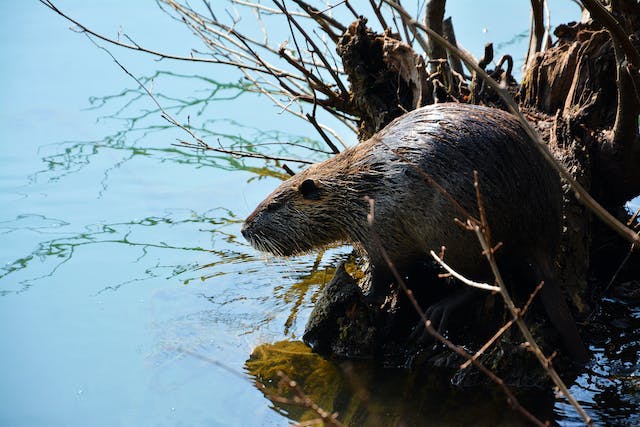
Why do beavers build dams? To make a deep pond that they can live in.
Beavers are rodents and they are the second largest rodents in the world. Only the capybara is bigger. However, unlike most other rodents, beavers are herbivores. They mainly eat tree bark, water plants, and grasses. Because they are mammals and they live in water, it is very easy to assume that they eat fish, but they don’t. They are strictly herbivores.
Beavers are not predators and they are eaten by a large variety of animals. There are two species of beaver: the North American beaver and the Eurasian beaver. The North American beaver is eaten by fisher cats, coyotes, hawks, bears, otters, lynx, eagles, mountain lions, owls, wolverines, and wolves. Eurasian beavers are eaten by foxes, bears, lynx, and wolves. Beavers are not completely defenseless, but they cannot defend themselves against large predators. They are fairly large, growing up to over a meter, and they can stand on their back legs to make themselves look taller. They also have sharp claws and strong teeth that they can use if they are threatened. They can defend themselves, but not too effectively and they much prefer to stay out of the way of the predators in the first place, and this is the reason why they build dams.
Beavers build a dam to flood a part of a river so that they can build a lodge. Beavers find a part of the river that is shallow and easy to dam. They know where is a good place by listening to the sound of the water. If the water is noisy, it means the river is shallow. When they hear the sound of fast running water, they will instinctively start to dam it. They begin by cutting down some large trees to go across the river. They have very sharp teeth and can cut down a 15 cm wide tree in less than 50 minutes. Once they have cut the tree down, they carry it in their mouths, They have very strong jaw and neck muscles. The long logs are placed in opposite directions across the direction of the water. When they have enough logs they carry heavy rocks to weigh the logs down and to keep them stable. They can carry rocks in their front paws and use their tails as a counterweight so that they can walk upright. They have very flexible fingers that are good for gripping.
Once the frame of the dam has been laid down and reinforced with rocks, the beavers start to drop smaller stones, dirt, grass, and smaller pieces of wood onto the dam. They drop these smaller pieces of material onto the dam from the upriver side of the dam. The current pushes the pieces completely into the dam, blocking up all of the holes. They slowly build up the upriver side of the dam until it is sloping far enough upstream to provide enough support against the current.
Once the dam completely cuts off the river, it starts to flood just upriver of the dam, creating a large pool. The beavers then build their den, called a lodge, right in the middle of this pond. The lodge is built from twigs, sticks, rocks, and mud. It is raised out of the water in the middle and it is hollow. They usually have two entrances from under the water. Large lodges can be up to ten meters across and about 2 meters above the level of the water. However, the larger the lodge, the larger the pool that is needed, and the larger the dam they have to build. The largest beaver dam every found was in Canada and it was 500 m long. Many smaller dams had been connected to make one enormous dam and a huge flooded area. Beaver are very sensitive to the sound of running water and they know when their dam has a leak. They rush to fix it very quickly.
Beaver are very safe inside their lodges because the majority of predators cannot get to them. They are usually only killed when they are on land, or swimming by the shore. However, one predator almost decimated the beaver over the last few hundred years and that was us. We hunted beaver for their pelts and the fur trade was the main reason why the interior of Canada was colonized. The pelts were the main material that hats were made out of. The hat industry also caused many exotic bird species to go extinct because they were hunted for their beautiful feathers. The beaver was almost made extinct, but luckily we realized what we were doing in time and the beaver has been able to make a recovery. And this is what I learned today.
Photo by Pierre Miyamoto: https://www.pexels.com/photo/eurasian-beaver-on-a-wood-12899887/
Sources
https://www.nps.gov/articles/buildabeaverdam.htm
https://www.sciencefocus.com/nature/why-do-beavers-build-dams
https://animals.mom.com/animal-eats-beavers-3602.html
https://en.wikipedia.org/wiki/Beaver
https://animals.mom.com/beaver-protect-itself-3899.html
